Author: Wuyue, Geek web3
As we all know, EVM is the "execution engine" and "smart contract execution environment" of Ethereum, and can be said to be one of the most important core components of Ethereum. The public chain is an open network with thousands of nodes. The hardware parameters of different nodes vary greatly. If you want smart contracts to run the same results on multiple nodes and meet "consistency", you must try to build the same environment on different devices, and virtual machines can achieve this effect.
Ethereum's virtual machine EVM can run smart contracts in the same way on different operating systems (such as Windows, Linux, macOS) and devices. This cross-platform compatibility ensures that each node can get consistent results after running the contract. The most typical example is the Java virtual machine JVM.
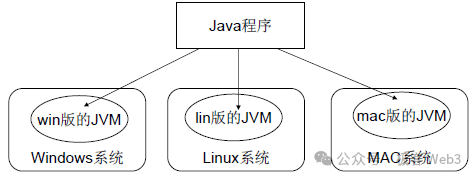
The smart contracts we usually see in the block browser are first compiled into EVM bytecode and then stored on the chain. When executing the contract, EVM directly reads these bytecodes in sequence. Each instruction (opCode) corresponding to the bytecode has a corresponding Gas cost. EVM will track the Gas consumption of each instruction during execution, and the consumption depends on the complexity of the operation.
In addition, as the core execution engine of Ethereum, EVM processes transactions in a serial execution mode. All transactions are queued in a single queue and executed in a certain order. The reason why parallelization is not used is that the blockchain must strictly meet consistency. A batch of transactions must be processed in the same order in all nodes. If the transaction processing is parallelized, it is difficult to accurately predict the transaction order unless a corresponding scheduling algorithm is introduced, but this will be more complicated.

Due to time constraints, the founding team of Ethereum in 2014-15 chose the serial execution method because it is simple in design and easy to maintain. However, with the iteration of blockchain technology and the growing user base, the blockchain has higher and higher requirements for TPS and throughput. After the emergence and mature implementation of Rollup technology, the performance bottleneck brought by EVM serial execution has been exposed on Ethereum Layer 2.
As a key component of Layer 2, Sequencer undertakes all computing tasks in the form of a single server. If the efficiency of the external modules that cooperate with Sequencer is high enough, the final bottleneck will depend on the efficiency of the Sequencer itself. At this time, serial execution will become a huge obstacle.
The opBNB team has optimized the DA layer and data read/write modules to the extreme, and the Sequencer can execute up to about 2,000 ERC-20 transfers per second. This number seems high, but if the transaction to be processed is much more complicated than the ERC-20 transfer, the TPS value will inevitably be greatly reduced. Therefore, parallelization of transaction processing will be an inevitable trend in the future.
Below we will start with more specific details and explain in detail the limitations of traditional EVM and the advantages of parallel EVM.
Two core components of Ethereum transaction execution
At the code module level, in addition to EVM, another core component related to transaction execution in go-ethereum is stateDB, which is used to manage account status and data storage in Ethereum. Ethereum uses a tree structure called Merkle Patricia Trie as a database index (directory). Every time EVM executes a transaction, it will change some data stored in stateDB, and these changes will eventually be reflected in Merkle Patricia Trie (hereinafter referred to as the global state tree).

Specifically, stateDB is responsible for maintaining the status of all Ethereum accounts, including EOA accounts and contract accounts. The data it stores includes account balances, smart contract codes, etc. During the transaction execution process, stateDB will read and write data for the corresponding account. After the transaction execution is completed, stateDB needs to submit the new status to the underlying database (such as LevelDB) for persistence.
In general, EVM is responsible for interpreting and executing smart contract instructions, changing the state on the blockchain based on the calculation results, while stateDB acts as a global state storage to manage the state changes of all accounts and contracts. The two work together to build Ethereum's transaction execution environment.
The specific process of serial execution
There are two types of Ethereum transactions, namely EOA transfers and contract transactions. EOA transfers are the simplest type of transactions, which is the transfer of ETH between ordinary accounts. This type of transaction does not involve contract calls and is processed very quickly. Due to the simplicity of operation, the gas fee charged for EOA transfers is extremely low.
Unlike simple EOA transfers, contract transactions involve the calling and execution of smart contracts. When EVM processes contract transactions, it interprets and executes the bytecode instructions in the smart contract one by one. The more complex the contract logic is, the more instructions are involved, and the more resources are consumed.
For example, the processing time of ERC-20 transfer is about twice that of EOA transfer, and for more complex smart contracts, such as trading operations on Uniswap, it takes longer and can even be more than ten times slower than EOA transfer. This is because the DeFi protocol needs to process complex logic such as liquidity pools, price calculations, token swaps, etc. during transactions, which requires very complex calculations.
So in serial execution mode, how do EVM and stateDB collaborate to process transactions?
In the design of Ethereum, transactions in a block are processed one by one in order, and each transaction (tx) has an independent instance to perform the specific operations of the transaction. Although each transaction uses a different EVM instance, all transactions share the same state database, that is, stateDB.
During the transaction execution process, EVM needs to constantly interact with stateDB, read relevant data from stateDB, and write the changed data back to stateDB.
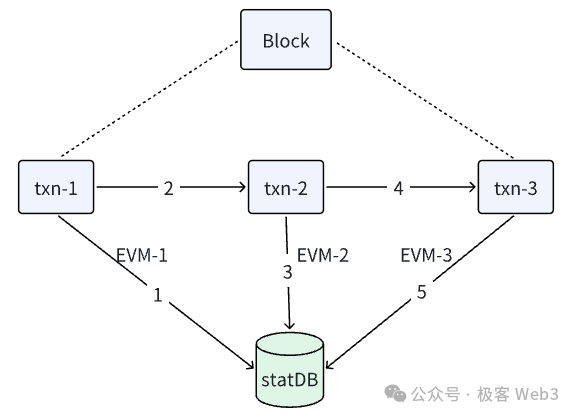
Let's take a look at how EVM and stateDB collaborate to execute transactions from a code perspective:
1. The processBlock() function calls the Process() function to process the transactions contained in a block;
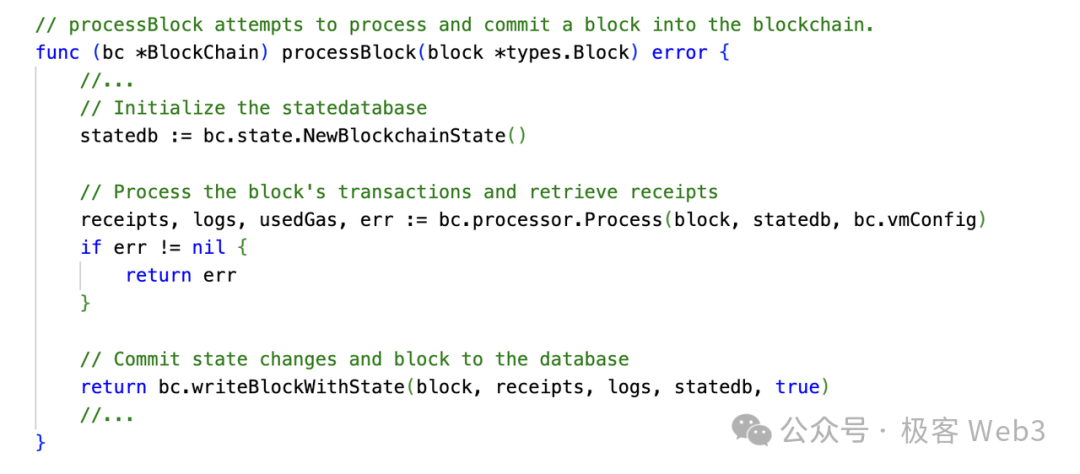
2. A for loop is defined in the Process() function, and we can see that transactions are executed one by one;

3. After all transactions are processed, the processBlock() function calls the writeBlockWithState() function, and then calls the statedb.Commit() function to commit the state change results.
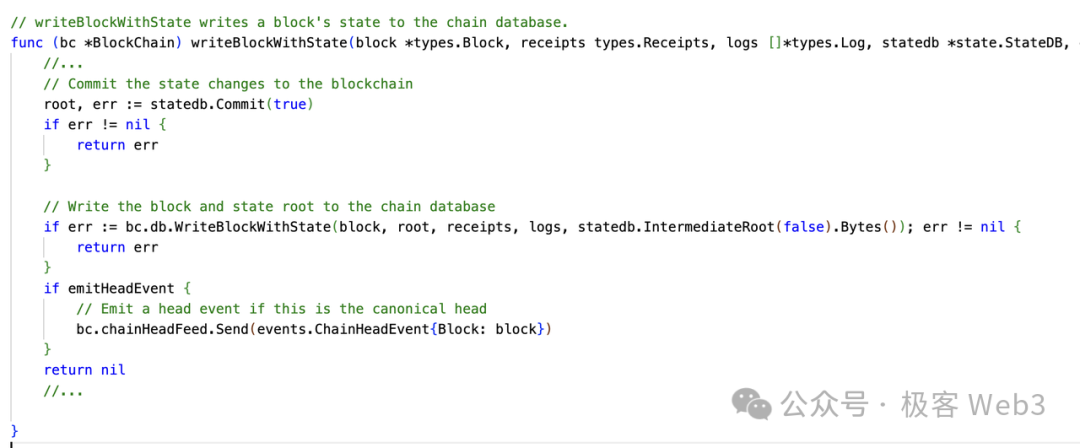
When all transactions in a block are executed, the data in stateDB will be committed to the global state tree (Merkle Patricia Trie) mentioned above, and a new state root (stateRoot) will be generated. The state root is an important parameter in each block, which records the "compression result" of the new global state after the block is executed.
It is not difficult for us to understand that the bottleneck of EVM's serial execution mode is obvious: transactions must be queued and executed in order. If there is a smart contract transaction that takes a long time, other transactions can only wait until it is processed. This obviously cannot make full use of hardware resources such as CPU, and efficiency will be greatly limited.
EVM's multi-threaded parallel optimization solution
If we use real-life examples to compare serial execution and parallel execution, the former is like a bank with only one counter, while the parallel EVM is like a bank with multiple counters. In parallel mode, multiple threads can be opened to process multiple transactions at the same time, and the efficiency can be improved several times, but the tricky part is the state conflict problem.
If multiple transactions all claim to rewrite the data of a certain account, conflicts will occur when they are processed at the same time. For example, only one NFT can be minted, and both transaction 1 and transaction 2 claim to mint the NFT. If their requests are all met, there will obviously be an error, and coordination is required to deal with such situations. Status conflicts in actual operations are often more frequent than what we mentioned, so if transaction processing is to be parallelized, measures must be taken to deal with status conflicts.
Reddio's parallel optimization principle for EVM
Let's take a look at the parallel optimization ideas of the ZKRollup project Reddio for EVM. Reddio's idea is to assign a transaction to each thread and provide a temporary state database in each thread, called pending-stateDB. The details are as follows:
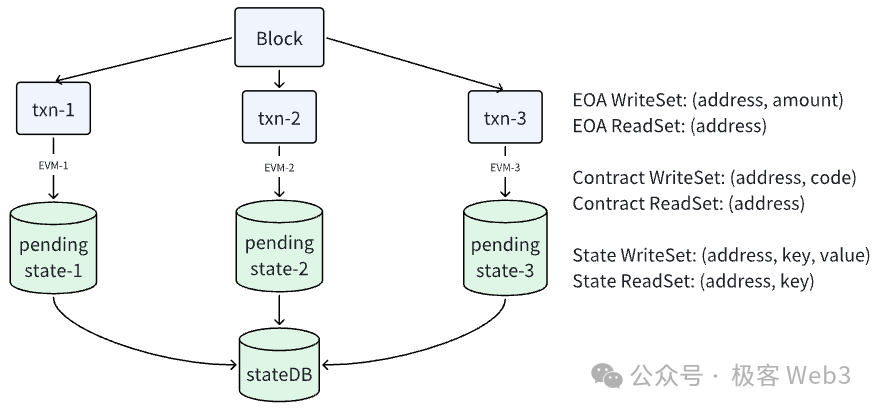
1. Multi-threaded parallel execution of transactions: Reddio sets up multiple threads to process different transactions at the same time, and the threads do not interfere with each other. This can increase the transaction processing speed several times.
2. Allocate a temporary state database for each thread: Reddio allocates an independent temporary state database (pending-stateDB) for each thread. When executing transactions, each thread will not directly modify the global stateDB, but temporarily record the state change results in the pending-stateDB.
3. Synchronize state changes: After all transactions in a block are executed, EVM will synchronize the state change results recorded in each pending-stateDB to the global stateDB in turn. If there is no state conflict between different transactions during execution, the records in pending-stateDB can be smoothly merged into the global stateDB.
Reddio optimizes the way read and write operations are handled to ensure that transactions can correctly access state data and avoid conflicts.
Read operation: When a transaction needs to read the state, EVM will first check the ReadSet of pending-state. If the ReadSet shows that the required data exists, EVM will read the data directly from pending-stateDB. If the corresponding key-value pair is not found in the ReadSet, the historical state data will be read from the global stateDB corresponding to the previous block.
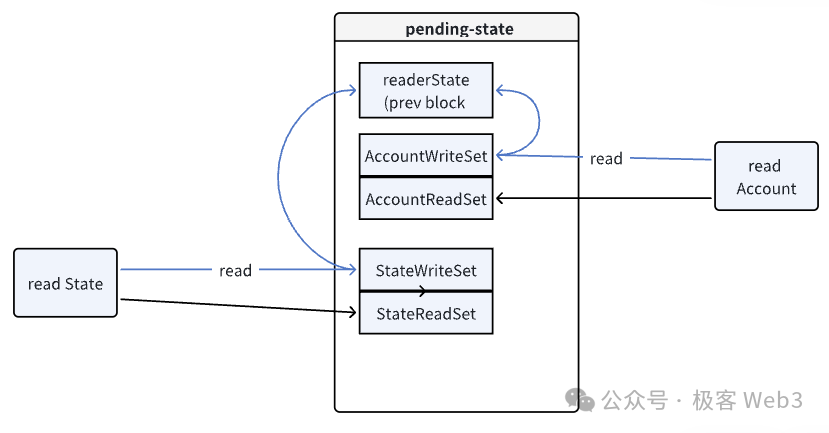 Write operations: All write operations (i.e., modifications to the state) are not written directly to the global stateDB, but are first recorded in the WriteSet of Pending-state. After the transaction is executed, conflict detection is performed and then the state change results are merged into the global stateDB.
Write operations: All write operations (i.e., modifications to the state) are not written directly to the global stateDB, but are first recorded in the WriteSet of Pending-state. After the transaction is executed, conflict detection is performed and then the state change results are merged into the global stateDB.
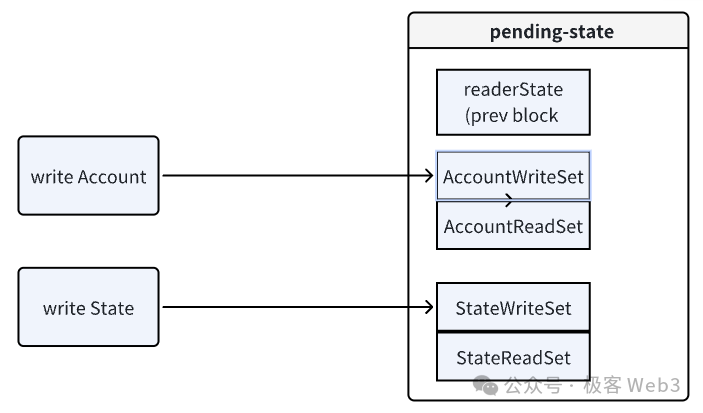 The key problem with parallel execution is state conflicts, which is particularly prominent when multiple transactions attempt to read and write the state of the same account. For this reason, Reddio introduced a conflict detection mechanism:
The key problem with parallel execution is state conflicts, which is particularly prominent when multiple transactions attempt to read and write the state of the same account. For this reason, Reddio introduced a conflict detection mechanism:
Conflict detection: During the transaction execution, EVM monitors the ReadSet and WriteSet of different transactions. If multiple transactions are found to attempt to read and write the same state item, a conflict is considered to have occurred.
Conflict handling: When a conflict is detected, the conflicting transaction will be marked as needing to be re-executed.
After all transactions are executed, the change records in multiple pending-stateDBs will be merged into the global stateDB. If the merge is successful, EVM will submit the final state to the global state tree and generate a new state root.
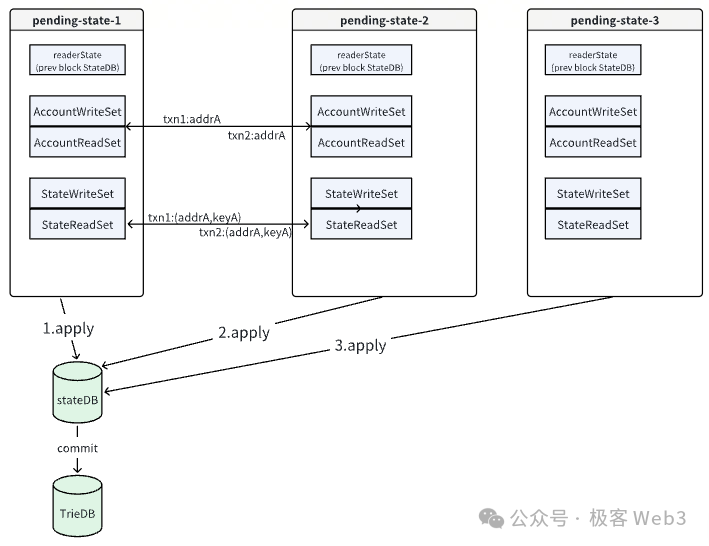 The performance improvement of multi-threaded parallel optimization is obvious, especially when dealing with complex smart contract transactions.
The performance improvement of multi-threaded parallel optimization is obvious, especially when dealing with complex smart contract transactions.
According to the research on parallel EVM, in low-conflict workloads (transactions with fewer conflicts or occupying the same resources in the transaction pool), the TPS of the benchmark test is about 3~5 times higher than that of traditional serial execution. In high-conflict workloads, theoretically, if all optimization methods are used, it can even reach 60 times.
Summarize
Reddio's EVM multi-threaded parallel optimization solution significantly improves the transaction processing capabilities of EVM by allocating a temporary state library for each transaction and executing transactions in parallel in different threads. By optimizing read and write operations and introducing a conflict detection mechanism, the EVM public chain can achieve large-scale parallelization of transactions while ensuring state consistency, solving the performance bottleneck caused by the traditional serial execution mode. This lays an important foundation for the future development of Ethereum Rollup.
Later, we will further analyze the implementation details of Reddio, such as how to further improve efficiency by optimizing storage efficiency, optimization solutions when conflicts occur frequently, and how to use GPU for optimization, etc.













